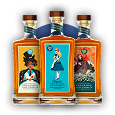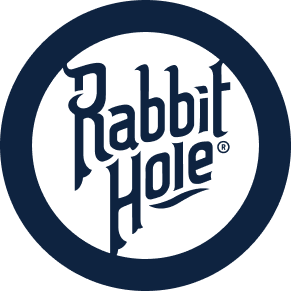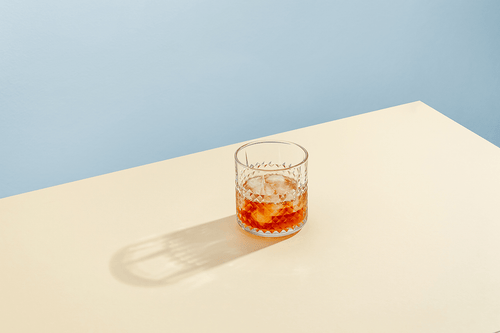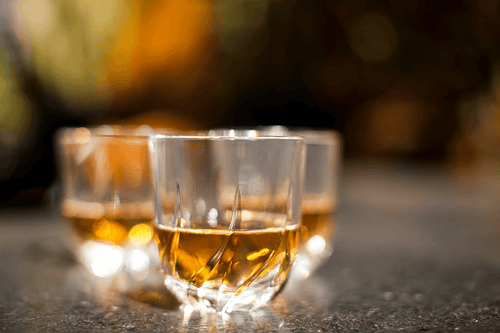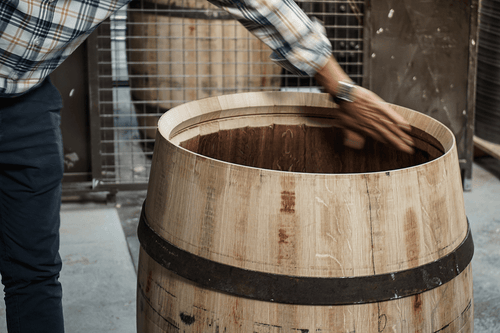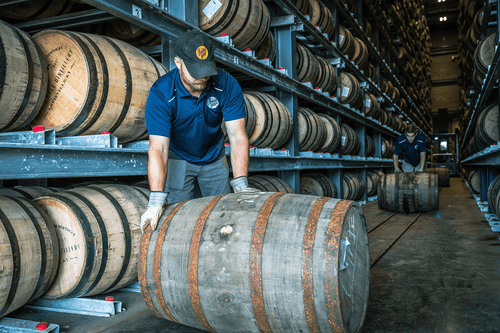Bourbon Fermentation: The Complete process
BOURBON FERMENTATION:
THE COMPLETE PROCESS
Production of every kind of whiskey, including bourbon, begins with the mash bill, which determines the types of grain used, and in what proportions, for each particular whiskey. Each grain adds a distinct flavor that contributes to the taste characteristics of the bourbon fermentation...

Bourbon has been experiencing a boom in popularity in recent years, with many drinkers changing from their usual tipple. In response, more and more varieties of bourbon are appearing at local bars and on liquor store shelves, giving discerning drinkers even greater choice. As smaller craft distilleries spring up, many people are moving away from the big brands to sample the diverse array of available bourbons.
However, all bourbon-makers are bound by the same strict rules and mostly use similar ingredients and equipment. The master distiller's skill in creating a unique recipe is what makes their product stand out from the rest. When choosing a whiskey, you'll be better informed if you know how bourbon fermentation, distillation, and aging is done.
Mash Bill
Production of every kind of whiskey, including bourbon, begins with the mash bill, which determines the types of grain used, and in what proportions, for each particular whiskey. Each grain adds a distinct flavor that contributes to the taste characteristics of the bourbon fermentation. The master distiller creates a mash bill, or recipe, that will produce the desired flavors of the end product.
To be called bourbon, the mash bill must contain at least 51% corn, but the rest of the mixture can be any combination of grains. For bourbon fermentation, most distillers use a mash bill of 60% to 80% corn, with the remainder typically made up of malted barley and rye or wheat. The same distillery may produce several different bourbons, each with its own unique bourbon fermentation mash bill to create a signature flavor.
For example, Rabbit Hole Distillery makes a range of products with very distinct bourbon fermentation recipes. For our high rye double malt Heigold Bourbon, we use 70% corn, 25% malted rye, and 5% malted barley. This blend of grains produces a sweet, toasted malt aroma and flavors of butterscotch and citrus with a spicy, peppery finish.
Cavehill Kentucky Straight Bourbon Whiskey is a four-grain triple malt bourbon made from 70% corn, 10% malted wheat, 10% malted barley, and 10% honey malted barley. You'll find it offers aromas of spice, honey, and apples, with the creamy taste of orange, honey, mint, and toasted grain, and a finish of vanilla and custard.
The Dareringer Straight Bourbon Whiskey is produced from 68% corn, 18% wheat, and 14% malted barley. The high wheat content gives you aromas of caramel and cherry and a smooth flavor comprising notes of raisins, currants, and cherries, with hints of almond and vanilla.
As you can see, these Rabbit Hole bourbons all have very different flavor characteristics because of the variations in the bourbon fermentation mash bills. However, some adventurous producers take the process even further by experimenting with more exotic grains, such as buckwheat, quinoa, oats, sorghum, amaranth, and rice.
Malted Grain
Generally, all bourbon fermentations feature malted barley in the mash bill, but other grains can also be malted to alter the flavor profile of the whiskey. The malting of grain has been used for centuries, as it helps the conversion of starches in the cereal into sugars and releases enzymes to aid bourbon fermentation. Malting “deceives” the cereal into thinking it's been planted, and it prepares itself to grow.
The first step in malting is called steeping, which increases the grain's moisture content by covering it with water. It's then left to dry on grain beds until it begins to germinate. The grain beds are turned regularly to allow enough airflow for the grain to dry. At the point where the grain begins to sprout, the germination process is abruptly halted by heating and drying the grain in a kiln. The darker color of the malted grain is produced by the high temperatures of the kilning process.
Milling the Grain
Whatever types and ratio of grains are to be used in the bourbon fermentation mash bill, the grains need to be ground separately and temporarily stored in separate containers. Before grinding, the grains go through a de-stoning process to remove any gravel, stones, or rocks that could damage the milling machines. Typically, distilleries use hammer mills or roller mills for grinding the grains.
Often, hammer mills are used to grind unmalted grain, like corn. These mills have rotating hammers that smash the grains. Malted grains, such as malted barley, are usually ground in roller mills that use sets of rollers to gently crush the grains. This opens the husk and helps to break down the enzymes from the starches. The cereal might be ground three or four times to achieve the right consistency for the bourbon fermentation.
Preparing the Bourbon Mash
Before the bourbon fermentation process can begin, the distiller must prepare the bourbon mash. Mashing is a process that creates and extracts both fermentable and non-fermentable sugars from the grains and helps draw out the specific flavor elements of each type of grain.
For mashing, the grains from the mash bill are added to water and yeast in a large vat or grain cooker. The mixture is heated at different temperatures, and sometimes at different pressures, to ensure the ingredients combine well and are prepared to ferment. The mash is agitated by paddles throughout the mashing process, which takes around 30 to 60 minutes.
Corn is added first as it needs to be cooked at higher temperatures for a longer time. Then the temperature is lowered, and the rye, wheat, or other grains are added. Malted barley is the most efficient grain at converting starch into sugar, so that is added last and cooked at lower temperatures for the shortest time. The last stage of the mashing process is to rinse the spent grain to optimize the release of the sugars.
It's not just the choice of grain types that's crucial for the flavor of the bourbon. Both the type of water and yeast used in the mashing and bourbon fermentation can affect the taste profile of the end product.
Kentucky Limestone Water
While there is no law regarding the water source used to make bourbon, aficionados believe that only limestone water should be used. Fortunately, Kentucky, where around 95% of bourbon is produced, has an abundance of water filtering through the limestone rock formations beneath the surface.
And, rather than being just a tradition, there are scientific reasons for using limestone water during bourbon fermentation. Limestone water has a high pH value, which aids fermentation, adds good minerals, and filters out contaminants and impurities that can negatively affect the flavor of the whiskey.
However, contrary to popular belief, bourbon can be made anywhere in the U.S., and not all distilleries have access to the pure Kentucky spring water. These producers can use ordinary tap water in their mash, but they use a purification process called reverse osmosis to remove impurities and bacteria.
Rabbit Hole Distillery only uses the limestone-rich Kentucky water in the production of our outstanding Kentucky straight bourbon whiskeys.
Yeast
The choice of yeast is also vital for the bourbon fermentation process. Different strains of yeast can react on the grains differently according to the conditions during fermentation, ultimately affecting the character of the bourbon. Many distilleries have their own proprietary live culture yeast varieties that have been grown for generations. Some strains have survived in cold rooms since the prohibition days. Other distillers buy their yeast from commercial producers in either live or dried varieties.
Bourbon Fermentation
Fermentation has been used for the production of beverages since the Stone Age, and documentation of its use dates back to 7000 B.C. in China. The early fermented wines and liquors were generally produced for medicinal purposes. Thanks to scientists such as Louis Pasteur in the 1800s, the fermentation process became better understood and more refined, but essentially the same process is used today for bourbon fermentation as for those concoctions made in ancient times.
After mixing together and heating the perfect blend of grains, water, and yeast, the mash is cooled to around 77 to 86 degrees Fahrenheit and transferred to fermentation tanks. For bourbon fermentation, the whole mash, including the solids, is used. This differs from whiskey production in other countries, where only the sugary liquid, known as wort, is sent to the fermenter. At this stage, more yeast is added to the mix, along with stillage, also known as backset or sour mash.
Bourbon fermentation typically takes three days, during which the yeast converts the grain sugars into alcohol (ethanol or ethyl alcohol) and carbon dioxide. The liquid produced through fermentation is known as distiller's beer, or simply beer, which reaches an alcoholic content of around 8% to 9.5% ABV. Some distillers allow the fermentation process to continue longer, which can result in an alcohol content of 10% to 11% ABV.
Bourbon is distilled in column stills which run continuously, requiring a constant supply of distiller's beer to stop them from running dry. The fermentation tanks vary in size from large to huge, and among the fermenters is a beer well into which the fermented beer is emptied. Usually constructed from stainless steel, the beer well is generally a third bigger than the bourbon fermentation tanks and is kept topped off to keep the column stills supplied with beer.
After bourbon fermentation, the distiller's beer is sent to the stills, where it is distilled into a clear, raw spirit known as white dog.
What Is Sour Mash?
Almost all bourbon distilleries use the sour mash process for bourbon fermentation. Controlling the new bourbon mash's pH is essential because harmful bacteria can emerge if the pH is too high, possibly tainting the taste profile of the whiskey. For this reason, distilleries need to sour the mash, which increases the acidity, making the mix more hostile to bad bacteria and more receptive to the yeast.
Sour mash is the spent grain from a previous bourbon distillation, which is acidic and rich in nutrients. As well as helping control bacteria and the pH content, it also contains dead yeast, which is a great food source for the live yeast. Typically, distillers will use a ratio of 1-to-3 or 1-to-4 sour mash to new mash. Fortunately, a distillery has a constant supply of sour mash left over after each batch of bourbon fermentation.
Although sour mash is considered a waste product of whiskey distilling, it could be more accurately described as a by-product. In addition to aiding the new bourbon fermentation, the mash is used as feed for livestock. Despite its name, the mash doesn't impart any sour flavor to the whiskey.
Column Stills
Most U.S. bourbon distilleries use column stills rather than the pot stills favored by other whiskey-producing nations. During the early 1800s, various attempts were made to develop a continuous distillation process. But it was Irishman Aeneas Coffey who built on earlier designs to produce the Coffey still, which was patented in 1830 and is the most commonly used still for American whiskeys.
Column stills have an upright tubular design that makes it possible to maintain continuous distillation, as long as there is a constant supply of new distiller's beer from the bourbon fermentation fed into the still. American whiskey column stills range in height from 16 to 65 feet, with a diameter of 27 to 72 inches. Inside the still are vertical pipes and a series of horizontal trays called stripping plates, or just plates, which have holes in them. Liquid flows down the pipes and gets heated until it turns to vapor, which then rises up through the plates.
Distillation Process
Like fermentation, distillation goes back to ancient times, with evidence of using the process for perfumes described on tablets from Mesopotamia dated 1200 B.C. The distillation of beverages is believed to have emerged in China in the 12th or 13th century. The practice of distilling was widely known throughout Western Europe by the end of the 13th century. While distillation has evolved into the process we know today, the methods used have proved much the same over the centuries.
Once the bourbon fermentation has been completed, the distiller's beer contains ethanol, which is contaminated with carbon dioxide and congeners, which can be noxious or toxic, and, if left in the whiskey, can be harmful. Congeners are the main cause of hangovers. The distillation process removes the bad congeners, retains the good compounds, and increases the alcohol content of the whiskey.
The distillation process starts when the distiller's beer from the bourbon fermentation is pumped about halfway up the still and begins flowing downward toward the heat source. As it's heated, the liquid evaporates and the vapor ascends through the stripping plates. At every plate, the vapor leaves behind some condensation. With the continuous heat coming through, the condensation is redistilled and reverts back to vapor.
At each stage of this repeated vapor to liquid to vapor process, some of the heavier compounds, such as fusel oils and harmful congeners, are separated from the ethyl alcohol. As the impurities from the bourbon fermentation are removed, the purity of the whiskey increases. The tallest stills can produce a spirit that's more than 95% ABV (190 proof), although by law bourbon must not be distilled to more than 80% ABV (160 proof).
When the alcohol is pure enough, it's fed into a copper pot still, known as a doubler, for a second distillation. During this stage, it undergoes a catalytic conversion that removes sulfur and other noxious compounds. This improves the flavor of the bourbon and boosts the alcohol content. After distillation, the vapor goes into a condenser where it returns to a liquid state. This is the raw whiskey spirit called white dog. The whiskey is then pumped into retention tanks ready for barreling. It must be put into the barrels at no more than 62.5% ABV (125 proof).
Barrel Choice
The choice of barrel for aging the whiskey is almost as important as the bourbon fermentation and distillation processes for determining the flavor of the final product. According to federal law, bourbon barrels must be unused and made from charred oak.
For aging our Rabbit Hole bourbons, we use high-quality 53-gallon barrels crafted from the finest American white oak by the Kelvin Cooperage. The barrels are slowly toasted over a wood-fired flame and then charred. The toasting and charring process takes up to 20 minutes. Originally established on the banks of the River Kelvin in Scotland, the cooperage has since relocated to Louisville, Kentucky.
Toasting draws out the sugars from the wood fibers to create a caramelized layer. Charring is a stronger process that uses a larger flame that burns the staves of the barrel for six to 12 seconds to produce a layer of charcoal. The resulting sugars and charcoal combine with the spirit to give the bourbons their rich, golden coloring and a deeper complexity of flavors and aromas.
As American whiskey can only be aged in new barrels, the used bourbon barrels are sold on for other purposes. Some Scotch distilleries age their whisky in bourbon casks to impart it with a unique flavor profile. Even a cigar producer creates a one-of-a-kind product by aging the tobacco leaves in bourbon casks.
Bourbon Aging and Storage
After bourbon fermentation and distillation, the whiskey is put into the new charred oak casks to mature. The law doesn't stipulate a minimum aging requirement for bourbon, and whiskey matured for as little as three months can be labeled as bourbon. However, to be labeled as straight bourbon whiskey, such as Rabbit Hole's bourbons, it must be aged for at least two years. Bottled-in-bond bourbon falls into a subcategory and must be aged for a minimum of four years. Generally, a good bourbon is barrel-aged for two to three years.
During the aging process, the barrels of bourbon are typically stored in warehouses of four or five floors, with each floor holding three to six layers of casks. The climate in different areas of the warehouses can vary widely, with high temperatures at the top and the lower areas as cool as an air-conditioned room. The warehouses have many windows to equalize the temperature with the outside climate.
The difference in temperature means the bourbon matures differently depending on its location in the building. In former times, the casks were rotated to different areas throughout the maturation process, so each could benefit from the ideal position in the center at some point.
Today, it is more common for distilleries to blend bourbons from different areas of the warehouse, which is much less labor intensive and achieves a similar result. Not having to rotate the barrels also frees up an area in the center of the building where distilleries can store special casks designated for bottling as single barrel bourbon or small batch bourbon, such as those produced by Rabbit Hole Distillery.
Bottling
The master distiller will keep a close eye on the aging bourbon and periodically taste it. After having gone from bourbon fermentation through distillation to aging, the whiskey is now ready for bottling. Some distilleries will chill-filter the whiskey at this point to remove protein molecules that might affect the clarity of the bourbon. However, this filtration can dilute the flavor of the whiskey and affect the feel on the palate. For this reason, Rabbit Hole bourbons are never chill-filtered.
For bottling, the bourbon must be at last 40% ABV (80 proof). The contents of the barrels are emptied over filters into troughs. Any charcoal remnants from the barrel staves are filtered out. The bourbon is then sent to a holding tank from which it is fed to the automatic bottling line. The next stop for the bourbon is the shelves of your local liquor store.
As you can see, a lot of care has gone into the production of your bourbon. All American whiskeys go through pretty much the same bourbon fermentation, distilling, and aging during the manufacturing process. But each individual bourbon will have a unique flavor profile, even with different drinks from the same distillery. The only way to determine which ones suit your taste buds is to start sampling. With so many bourbons to choose from, you're in for a pleasant journey.














